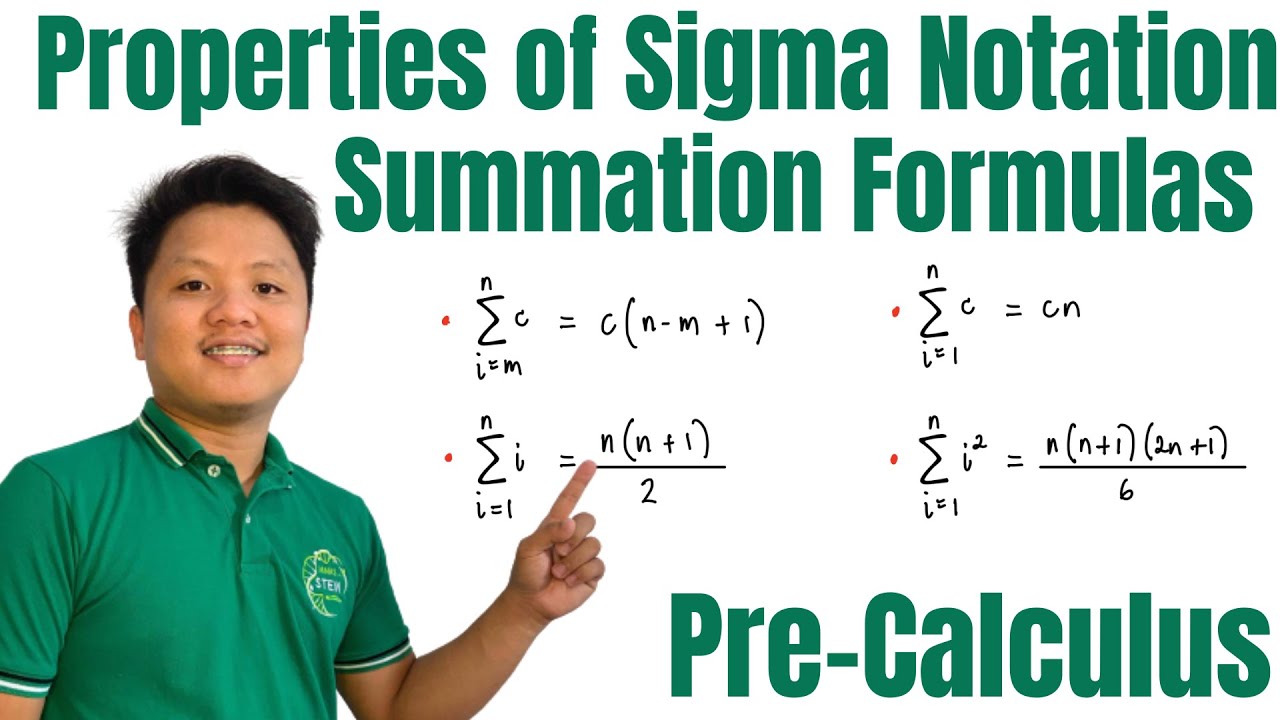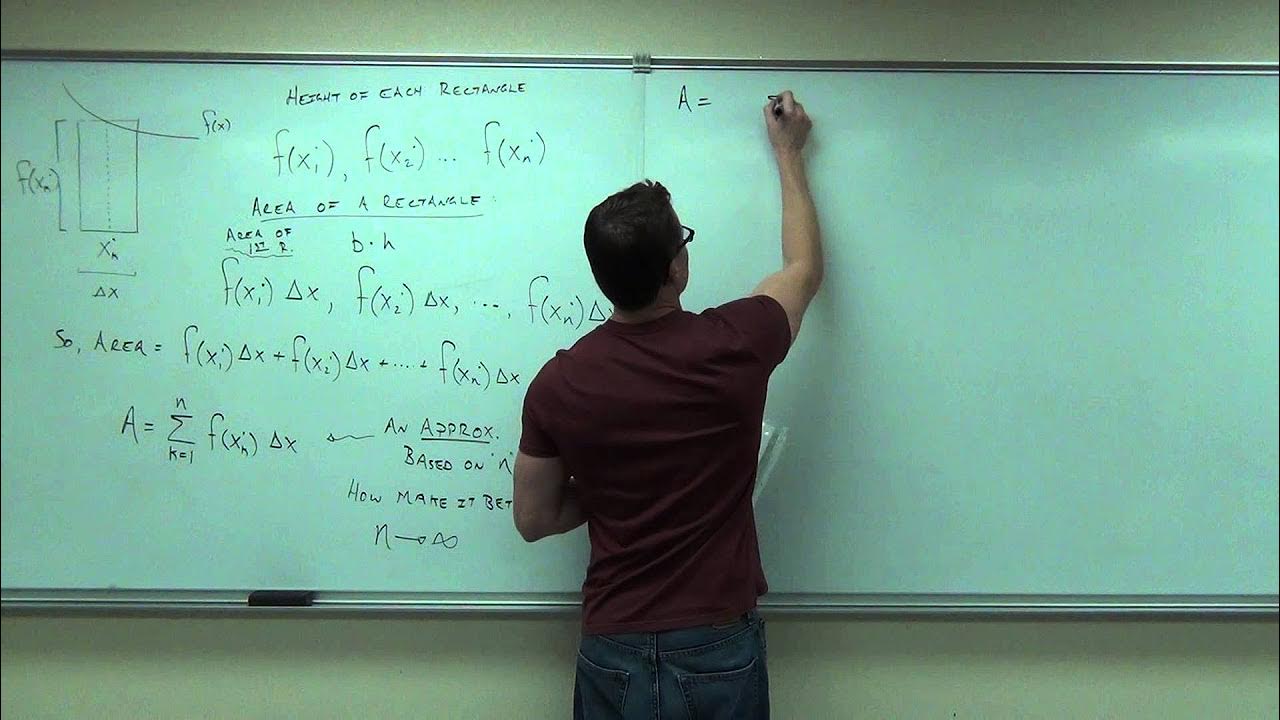PROPERTIES OF SIGMA NOTATION || PRE-CALCULUS
TLDRThis instructional video delves into the properties of sigma notation, a fundamental concept in mathematics. It explains how to calculate the summation of a constant, the multiplication of a constant with a variable, and the summation of expressions involving multiple quantities. The presenter demonstrates these properties with examples and provides a step-by-step evaluation using given values. The video also covers practical applications, such as calculating the sum and squared sum of student scores, offering a comprehensive understanding of sigma notation's utility in mathematical computations.
Takeaways
- 📚 The first property of sigma notation states that the sum of a constant (a) from 1 to n equals n times the constant (a * n).
- 🔢 When a constant (c) is multiplied by a variable in a summation, it can be factored out, resulting in c times the sum of the variable (c * Σx_i).
- ➕ The sum of an expression with multiple terms can be broken down into the sum of each term's summation separately (Σ(x_i^2 - x_i + 2)).
- 💡 Evaluate the sum of a constant times a variable for a given range (Σ(8 * x_i) for i = 1 to 5) by multiplying the constant with each variable's value and summing them.
- 📈 Given individual sums for different variables (Σx_i, Σy_i, Σz_i), the combined sum can be found by adding these sums together (Σ(x_i + y_i + z_i)).
- 🤓 To find the total of a constant multiplied by each term in a summation, multiply the constant by the sum of the terms (3 * Σx_i + 4 * Σy_i - 70).
- 🧮 For a set of numbers, the sum can be calculated by adding all the numbers together, and the sum of their squares can be found by squaring each number and then summing them.
- 📊 The script provides an example calculation of the sum and the sum of squares for five students' math scores, resulting in 406 and 336,844 respectively.
- 🎓 The video lesson is educational, aiming to teach viewers about the properties and applications of sigma notation in mathematics.
- 📈 The concept of summing a series can be applied to various mathematical problems, including those involving constants and variables.
- 👍 The presenter encourages viewers to like, subscribe, and hit the bell button for more video tutorials, indicating the channel's goal to provide ongoing educational content.
Q & A
What is the first property of sigma notation discussed in the video?
-The first property discussed is that the summation of a constant 'a' taken from 1 to n equals n multiplied by the constant, which is expressed as \( \sum_{i=1}^{n} a = n \cdot a \).
Can you provide an example illustrating the first property of sigma notation?
-Sure, if you take the summation of 10 times a constant 'c' where 'i' is from 1 to 8, it would be calculated as 8 times 10, which equals 80.
What is the second property of sigma notation presented in the video?
-The second property is that the summation of a constant multiplied by a variable is equal to the constant multiplied by the summation of the variable, which can be written as \( \sum_{i=1}^{n} c \cdot x_i = c \cdot \sum_{i=1}^{n} x_i \).
How does the video demonstrate the application of the second property with an example?
-The video provides an example where the summation of a constant 'c' times a variable 'x_i' from 'i' equals 1 to 'n' is shown. It simplifies to 'c' times the summation of 'x_i' from 'i' equals 1 to 'n'.
What is the third property of sigma notation explained in the video?
-The third property states that the summation of an expression with two or more quantities is equal to the sum of their individual summations, which can be represented as \( \sum_{i=1}^{n} (expression_1 + expression_2) = \sum_{i=1}^{n} expression_1 + \sum_{i=1}^{n} expression_2 \).
Can you explain the example given in the video for the third property?
-The example involves the summation of 'x_i^2 - x_i + 2' where 'i' is from 1 to 'n'. It is broken down into the summation of 'x_i', the summation of '-x_i', and the constant summation of '2'.
What values are given for x_sub_i from i=1 to i=10 in the video?
-The values given for x_sub_i are: x_sub_1 = 8, x_sub_2 = 9, x_sub_3 = 12, x_sub_4 = 15, x_sub_5 = 6, x_sub_6 = 3, x_sub_7 = 10, x_sub_8 = 5, x_sub_9 = 2, and x_sub_10 = 1.
How is the summation of 8 times x_sub_i evaluated for i=1 to i=5 in the video?
-The summation is evaluated by multiplying 8 with each of the given values of x_sub_i for i=1 to i=5 and then summing them up to get a total of 50.
What is the result of the summation of x_sub_i from i=1 to i=10, y_sub_i from i=1 to i=10, and z_sub_i from i=1 to i=10 in the video?
-The result of the summation of x_sub_i, y_sub_i, and z_sub_i from i=1 to i=10 is 285, which is obtained by adding the individual summations of 55, 65, and 165 respectively.
How is the summation of three times x_sub_i plus four times y_sub_i minus seven evaluated in the video?
-The summation is evaluated as 3 times the summation of x_sub_i plus 4 times the summation of y_sub_i minus 7 times 10, which simplifies to 165 plus 260 minus 70, resulting in 355.
What is the sum of the scores of five students in mathematics given in the video?
-The sum of the scores, which are 75, 80, 97, 91, and 63, is calculated to be 406 using a calculator.
What is the value of the summation of the square of the scores of the five students in mathematics?
-The value of the summation of the square of the scores (75^2 + 80^2 + 97^2 + 91^2 + 63^2) is 33,684 as calculated using a calculator.
What is the final result when the sum of the scores is squared and added to the individual scores in the video?
-The final result is obtained by squaring the sum of the scores (406^2) and adding it to the sum of the scores (406), which equals 1,164,836.
Outlines
📚 Introduction to Sigma Notation Properties
This paragraph introduces the concept of sigma notation and its basic properties. The first property explained is the summation of a constant 'a' from 1 to 'n', which is equal to 'n' multiplied by 'a'. An example is given with the summation of 'c' where 'i' ranges from 1 to 'n', equating to 'n' times 'c'. The second property discussed is the summation of a constant multiplied by a variable, which can be rearranged to a constant times the summation of the variable. The third property is about the summation of an expression with multiple terms, which can be broken down into the sum of their individual summations. An example is provided with the summation of 'x_i^2 - x_i + 2', demonstrating how to expand and simplify the expression. The paragraph concludes with an application of these properties using specific values for 'x_i' from 1 to 10, and calculating the summation of '8 times x_i'.
🔢 Evaluating Sigma Notation Expressions
The second paragraph focuses on evaluating various sigma notation expressions using the properties discussed earlier. It starts by calculating the summation of '8 times x_i' for 'i' ranging from 1 to 5, using the given values of 'x_i'. The result is found to be 400. The paragraph then evaluates the summation of 'x_i + y_i + z_i' for 'i' from 1 to 10, with the given summations of 'x_i', 'y_i', and 'z_i' being 55, 65, and 165 respectively, leading to a total of 285. Next, an expression involving '3 times x_i + 4 times y_i - 7 times a constant' is simplified and evaluated, resulting in 355. Finally, the paragraph concludes with a real-world example of calculating the average and sum of squares of five students' scores in mathematics, with the scores being 75, 80, 97, 91, and 63.
📉 Conclusion and Final Calculations
In the final paragraph, the video script wraps up with a summary of the calculations performed and a brief mention of the results. The summation of the students' scores is calculated to be 406, and the summation of the squares of the scores is found to be 33,684. Additionally, the script humorously attempts to square the total sum of the scores, resulting in an exaggerated figure of 1,164,836. The video concludes with a thank you message, encouraging viewers to like, subscribe, and hit the bell button for more video tutorials, and introduces the guide for learning as the host of the channel.
Mindmap
Keywords
💡Sigma Notation
💡Summation
💡Constant
💡Variable
💡Multiplication
💡Substitution
💡Evaluation
💡Scores
💡Calculation
💡Square
💡Tutorial
Highlights
Introduction to properties of sigma notation.
Property 1: Summation of a constant from 1 to n equals n times the constant.
Example calculation: 10 times 8 equals 80.
Property 2: Summation of a constant multiplied by a variable equals the constant times the summation of the variable.
Property 3: Summation of an expression with multiple quantities equals the sum of their individual summations.
Example: Summation of (x_i^2 - x_i + 2) from i=1 to n.
Evaluation of summation of 8 times x_i from i=1 to 5.
Calculation result of 8 times x_i summation equals 400.
Given summations of x_i, y_i, and z_i from i=1 to 10 and their respective sums.
Evaluation of summation of (x_i + y_i + z_i) from i=1 to 10.
Result of summation of (x_i + y_i + z_i) equals 285.
Evaluation of the quantity of (3x_i + 4y_i - 7) from i=1 to 10.
Calculation result of (3x_i + 4y_i - 7) equals 355.
Example with scores of five students in mathematics.
Summation of scores equals 406.
Summation of squared scores equals 33,684.
Summation of squared scores plus additional terms equals 1,164,836.
Closing remarks and call to action for likes, subscriptions, and notifications.
Transcripts
Browse More Related Video

Properties of Sigma Notation and Summation Formulas | Pre-Calculus

Introduction to Basic Statistical Notation: Sigma and Summation

Summation Formulas and Sigma Notation - Calculus

Calculus 1 Lecture 4.3: Area Under a Curve, Limit Approach, Riemann Sums

Summation Notation (Statistics)

The Definite Integral Part II: Using Summation Notation to Define the Definite Integral
5.0 / 5 (0 votes)
Thanks for rating: